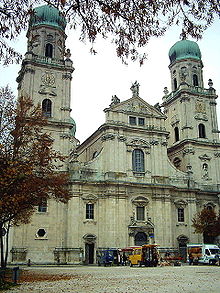Carlo Lurago
Carlo Lurago (also: Loragho, Luraghi, Luragho ; * 1615 in Pellio Superiore , Val d'Intelvi ; † October 22, 1684 in Passau ) was an Italian architect , builder and plasterer who was mainly active in Bohemia .
Life
Carlo Lurago is one of the group of Lombard architects and visual artists who are also called Comasken because of their origins in the area around Lake Como , and who worked mainly in Bohemia, but also in Silesia , Austria and southern Germany. Together with Giovanni Domenico Orsi de Orsini and Francesco Caratti , he was one of the most important architects of the Bohemian Baroque.
Lurago came from an extensive family of artists. His parents were Giovanni Antonio Lurago and Margaritha, nee Lurago. Nothing is known about his youth and his education. He married Elisabeth (NN) - presumably in Val d'Intelvi - and had two sons who died young.
At the age of 23 the trained stucco maker came to Prague and entered the service of the Jesuit order , for whom he carried out the remodeling and stuccoing of the Gothic Salvator Church on Kreuzherrenplatz from 1638 to 1640.
In 1648 he acquired citizenship and the freedom to trade in the Lesser Town of Prague and founded a well-organized construction company in which he employed the necessary building workers and made his nephew Francesco Anselmo Lurago a co-owner. This made him one of the busiest architects of his time and received orders from church institutions and the nobility for large building projects, some of which were carried out according to his plans and some for other architects.
Lurago's most extensive project was the Prague Clementinum from 1654 to 1679 , which was probably built based on a design by Francesco Caratti and with the help of foreman Martino Lurago. In addition, from 1649 to 1659, together with Santino Bussi and Giovanni Pieroni, he was employed in the imperial service of fortifications in Prague.
At Passau Cathedral , which was largely destroyed by fire in 1662, the double-towered west facade and a new central nave were built from 1668 according to Lurago's plans, in which a series of flat elliptical domes was built over pendentives for the first time . This vault solution became the model for numerous other high and late baroque buildings . Francesco della Torre , royal Prague stone mason, organized all the stone work. The precious stucco decoration was created in collaboration with Giovanni Battista Carlone and Antonio Carlone .
Construction projects
In Prague
- 1638–1648: Remodeling and stuccoing of the Gothic Salvatorkirche on Kreuzherrenplatz, old town
- around 1650: Reconstruction of the Church of St. Mary under the Chain , ( Kostel Panny Marie pod řetězem ) Lesser Town
- 1651: Reconstruction of the Lobkowitz Palace, Hradschin
- 1654–1679: Clementinum building wing , old town
- 1658: Stone bird houses
- 1665–1670: St. Ignatius Church ( Kostel svatého Ignáce ), New Town
- 1578–1653: St. Salvator's Church ( Kostel svatého Salvátora ) in the Clementinum
- 1673: St. Nicholas' Professorship, Lesser Town
In other places in Bohemia
- 1637–1659: Baroque town hall, Náchod
- 1642–1650: Jesuit College and Church of St. Franziskus and Ignatius, Bresnitz
- 1650–1659: reconstruction and expansion of Náchod Castle
- 1654–1666: Jesuit Church of the Assumption of Mary, Königgrätz
- 1654–1679: St. Ignatius Church ( Kostel svatého Ignace ), Klattau
- 1655–1661: Reconstruction of the castle in Neustadt an der Mettau
- 1657–1661: Reconstruction of the monastery and the monastery church in Svatý Jan pod Skalou
- 1659–1674: Church and cloister of the Příbram pilgrimage church
- 1663–1671: Remodeling of the St. Ignatius Church in Komotau
- 1663–1668: Monastery in the forest, Kladno
- 1665–1670: Trinity Church in Klösterle
- 1666–1668: Humprecht Castle
In Silesia
- 1660: Baroque chapel of the Franciscan monastery in Głogów
- 1680: stucco decoration of the nave ceiling of the parish church of Corpus Christi ( Kościół Bożego Ciała ), Brieg ( Brzeg Głogowski )
In County Glatz
- 1653–1658: The palace complex and the parish church of St. Maria Magdalena in Grafenort are remodeled and baroque
- 1654–1690: Jesuit college with Konvikt in Glatz
- 1660–1670: Redesign of the Church of the Assumption of Mary in Glatz into a gallery basilica
In Bavaria
- 1668–1684: St. Stephen's Cathedral , Passau
- 1641–1672: Carmelite Church of St. Joseph , Regensburg
In Austria
- 1670–1671: Maria Taferl pilgrimage church in Lower Austria
literature
- Hans Reuther : Carlo Lurago. In: New German Biography (NDB). Volume 15, Duncker & Humblot, Berlin 1987, ISBN 3-428-00196-6 , p. 527 f. ( Digitized version ).
- Biographical Lexicon for the History of the Bohemian Lands, Vol. II, ISBN 3-486-52551-4 , p. 520
- Dehio Handbook of Art Monuments in Poland, Silesia , Munich · Berlin 2005, ISBN 3-422-03109-X
- Knaur's Art Guide Czech Republic, ISBN 3-426-26609-1
Web links
- Carlo Lurago. In: arch INFORM .
| personal data | |
|---|---|
| SURNAME | Lurago, Carlo |
| ALTERNATIVE NAMES | Loragho; Luraghi; Luragho |
| BRIEF DESCRIPTION | Italian architect |
| DATE OF BIRTH | 1615 |
| PLACE OF BIRTH | Pellio Superiore in Val Intelvi |
| DATE OF DEATH | October 22, 1684 |
| Place of death | Passau |
